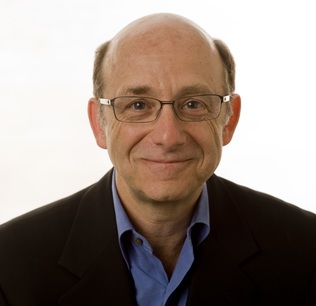Jonathan Markowitz is a member of Reconstructing Judaism’s Board of Governors and treasurer of Jewish Reconstructionist Congregation, in Evanston, Ill. On Sept. 11, 2001, he was on the 85th floor of One World Trade Center, and managed to descend to safety along with all of his staff. Last year, he recounted his experiences and reflections — his thoughts on God, Judaism and humanity — in this talk, delivered to the North Shore Post of the Jewish War Veterans of the United States of America.
I want to share my story about being in the World Trade Center on 9/11, how that has affected me Jewishly, and to share some of the lessons I learned and have taken to heart.
As I tell my story, I want you to be aware that I now tend to view world events through my 9/11 experience. Also, I was — and still am — encouraged by the people I was with during that time. Those nameless individuals kept my faith with humanity and have convinced me that people are good, and when put into a difficult situation will do the right thing. In this day and age of political strife and neo-Nazi marches, I have certainly had my doubts of late.
I want to start with a little background. I was in New York City because my job was to manage my company, SMW Trading Company’s New York office. SMW Trading Company was a large commodity clearing house, analogous to a bank, and a proprietary trading firm based in Chicago and New York.
I served as the New York manager and regularly went to New York to plan strategy and train my team.
Let me describe the World Trade Center complex as I knew it.
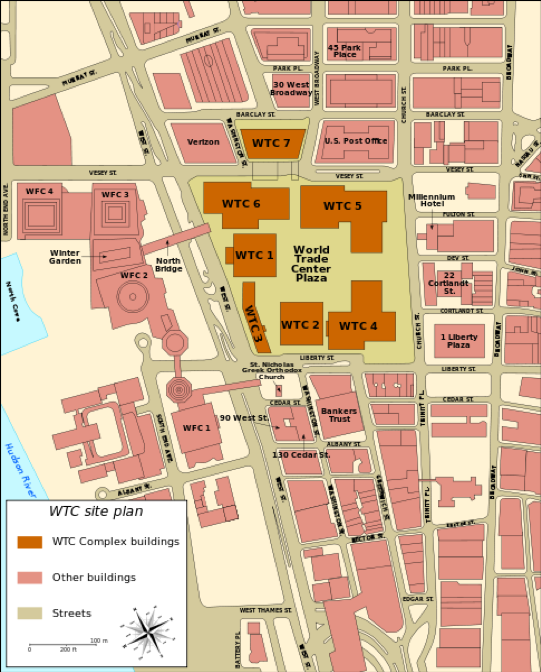
The WTC was a large complex of seven buildings. It was roughly four blocks long and two and a half blocks wide. The two towers were on the Southeast and Northwest corners of the complex with supporting buildings around the perimeter. Among other buildings, the World Trade Center included commodity exchanges, where the Eddie Murphy movie Trading Places was filmed, in addition to a hotel.
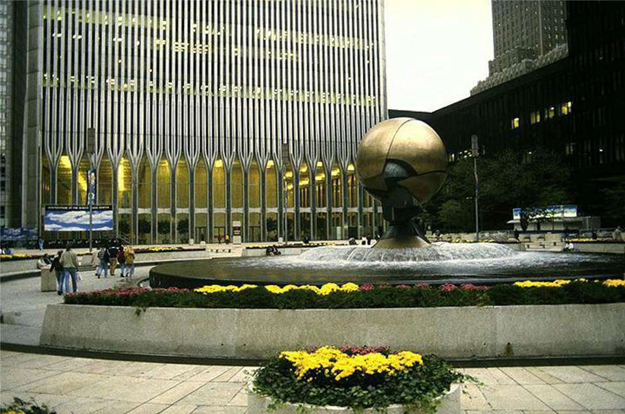
The WTC was built on two main public levels. The plaza level offered summer concerts, where people could sit on benches to have lunch. Directly below was an underground shopping mall with restaurants and businesses; you could buy anything at the WTC. In the center of the shopping mall was a PATH train terminal that connected New Jersey commuters to the Wall Street area.
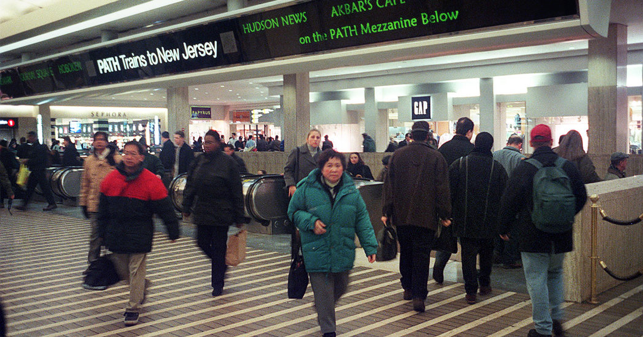
I heard that as many as 65,000 people a day passed through the World Trade Center mall.
Tuesday, September 11 started like every other day. The weather was beautiful, the skies were a rich blue — crystal-clear — and I was preparing to leave New York that afternoon to come home for parent-teacher conferences. Most of my staff was going about their tasks like any other day. There were jobs to commute to; car pools to drive; projects to finish; trading seminars to attend. No one had any idea what was literally on the horizon. As I listened to many of the people affected by the attack, it struck me how normal the day started off.
Now, let me tell you a little about myself. I have been in the commodity business and finance for more than 36 years. I have both traded in the pits and acted as a manager. Primarily, I was based in Chicago. We had a 40-person office in the World Trade Center that I managed and visited monthly.
As a businessperson, I have tried to run my business as Jewishly as possible. The Torah teaches (Leviticus 25:14) that you should be honest in your business dealings. So I paid employees fairly, and offered them a 401(k) and a solid health-insurance plan. My partners and I strived to uphold Jewish ethics. I am very proud of that.
We also considered an employee’s quest for growth. We implemented best practices and used various methods discussed in business seminars to insure the continued success and growth of my company. We even had contingency plan for various business problems. I thought that my growth as an individual and as a businessperson was on a clear, straight, recognizable path. But all that changed in the course of a single day.
On the morning of September 11, I was in my New York office on the 85th floor of One World Trade Center.
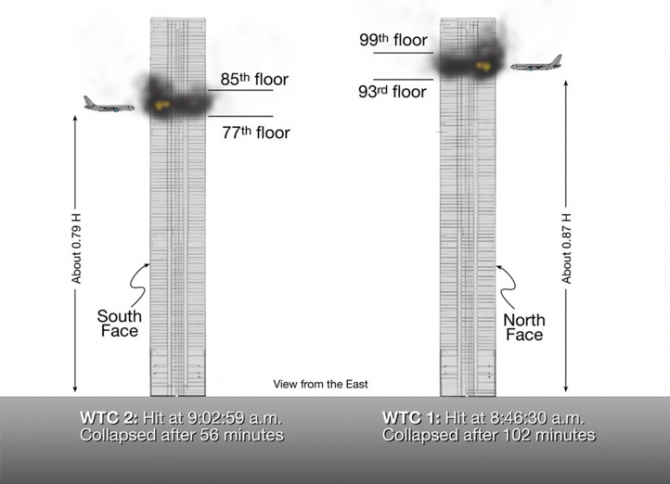
It was 8 a.m. East Coast Standard time, and the day’s commodity trading was about to begin. I phoned home and told my kids to have a good day at school. I told Ruth, my wife, that I was on schedule to be home that evening.
I was sitting in the conference room discussing that day’s trading with some of the junior traders when we heard a bang and felt pressure that sounded and felt like two trains passing at high speed. Simultaneously, the building leaned dangerously to one side. My first thought was an earthquake — that the building was going to topple — and so I braced myself for the impact. Suddenly, the building snapped back into place. Seconds later, our New York trading manager calmly walked into the conference room and said that he had just watched an airplane hit the building.
The idea of a terrorist attack didn’t even cross my mind. I envisioned a small, private plane piloted for sightseeing — not a fuel-laden 767. I was immediately concerned about the well-being of both my staff and the people in the plane. I looked out the window, and saw papers and office supplies floating like confetti in a ticker-tape parade. I quickly dialed 911 to tell the authorities that the plane crash was above the 85th floor of Tower One. Hurriedly, I gathered the staff and told everyone to leave the building now; we even pulled one guy out of the bathroom. We had no idea of the extent of the damage. We didn’t have CNN to bring us the gruesome details in living color over and over again until we became numb and nauseous. Nevertheless, we knew it was time to leave.
As I headed for the door, I grabbed my briefcase and my suitcase because I thought that it might be weeks before I could get them. We headed to the “B” stairwell to begin our multi-floor descent. As we were making our way to the stairs, we noticed small fires in the hall and had a brief scare when we actually forgot where the stairs were even located.
Here is one of my important lessons:
The event changed our perception of our surroundings. As we entered the hall, it looked different. There were ceiling tiles on the floor, and a small fire burned in the far corner. While no one was in any immediate danger, the extra pressure of the situation, the rush of adrenalin and the ominous change in our surroundings made us lose our bearings for a few moments. Previous fire and bomb drills were great for helping prepare us for when the real event occurred. While not a Jewish lesson, I wanted to say, take those drills seriously; they could help you survive an emergency.
After we exited the office, the disorientation lasted only a few moments. We quickly figured out where the stairs were and began our long climb down. On the 83rd floor, to break the tension, I asked the staff if we should remain in our offices when the lease expired in April. After reaching the 80th floor (huffing and puffing just a little), we unanimously voted to look for new space in a different building.
And that is one aspect of the event I felt was Jewish. I injected humor to keep the mood light. I don’t know which parashah says it’s OK to be funny, but hey, I’m Jewish — how about a nosh and a joke while we are doing something that could poke an eye out?
On the 77th floor, we encountered our first problem. A door in the stairwell connecting us to another corridor wouldn’t open. The people at the front of the line called out that the door was locked. Seconds later, someone else yelled that another door on another floor was open. So we exited through that door into a hallway that had holes in the floor, with the walls on fire. I had some experience with fires and fire hoses. When I was a kid, my family’s house caught on fire once while we were eating dinner, and in college, the students who lived in the dorms would pull out the fire hoses from the stairwells once a year and spray passing students. To me, the fire in the hallway didn’t look too bad, and though the holes were big, I never felt that I was in danger of falling into one or being burned. However, coworkers told me that there was a huge blaze, and that the floor was difficult to navigate.
Here is another example of perceived confusion from 9/11. Seconds after the plane hit, a fireball exploded through the hall. A staffer in the bathroom — a former member of the military — saw a fireball burn through our office and through the hall. He was sure that the whole building was on fire and that everyone in our office had died. The employees closest to the door were afraid to open it because they had seen the fireball rip through the building. Yet everyone was fine. Reality was different from observation.
And here is another lesson: Not everyone’s perception of an event is the same. I assumed that the person standing next to me witnessed the same thing — a small, manageable danger. But everyone views events through the lens of their own experiences. These differences happen in everyday life, and perception becomes important when a group is trying to achieve a goal. Simply put, we could not all escape if people were stuck and unable to move. I had to help those people navigate through the danger. This also reminds me of the parashah, Shelakh, about the spies in the Promised Land: Ten spies said there were giants, and that the grapes were beyond amazing. Yet two spies said that inhabiting the land would not be a problem. Perception can be a funny thing.
After a quick assessment of the danger, my staff and I moved around the fire into a second stairwell and continued our descent.
Many people have asked me what I was feeling, what I was thinking, on those 85 flights of stairs. Surprisingly, my main emotion at the time was boredom. We were hot and sweaty, and the stairs were clogged as greater numbers of people from the lower floors joined the escape. It took me more than 80 minutes — nearly an hour and a half — to reach the underground mall. Yes, we were concerned for our safety, but we were in an enclosed stairwell with no windows and no communication, and could not see the extensive damage to the building. In the stairwells, we heard rumors: there were four planes; someone had heard that there were eight planes; another person said that a plane tried to fly between the buildings. But each story seemed more implausible than the next.
During the entire morning, no one really comprehended what was going on. The amount of real information was negligible. The magnitude of the event simply wasn’t known; everyone was guessing. However, this didn’t stop our hunt for information. After a while, I ignored the speculation. At best, the rumors gave a false sense of security; at worst, they could spread panic. So we managed not to let the chatter detract us from our goal of getting out of there.
What we did while descending the stairs was talk and make small jokes — for example, we were sure that there would be T-shirts at the bottom of the stairs that would say, “I survived the 9/11 plane crash.”
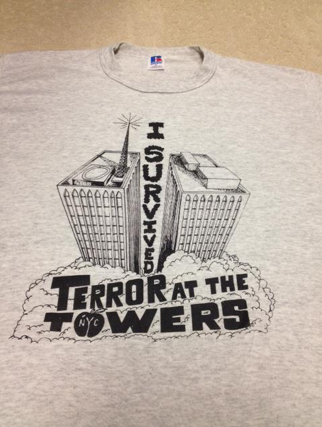
We tried not to slip in the water that was running down the stairs. We tried to help people who were having trouble walking down hundreds of stairs. We also stayed calm and worked together. We sensed that if panic replaced cooperation, then no one would make it.
After descending for a few minutes more, we heard someone yell: “To the right! To the right!” We moved aside as the wounded began to hobble down the stairs. It is very sobering to see people in shock, soaked in blood, passing you. Still, we didn’t lose it. We continued down, just a little more quietly.
As we approached the 45th floor, we began to see firemen on their way up.
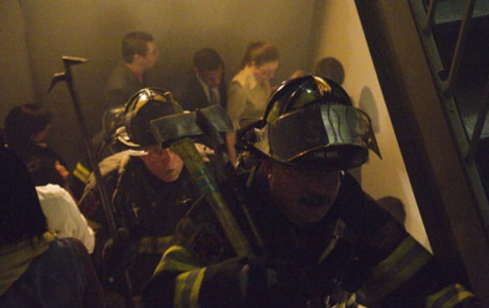
These guys were exhausted. They had been climbing, carrying 50 to 80 pounds of equipment, and would still have to fight the fire once they reached it. One fireman was having chest pains; he was resting in a hallway. For a while, there were two lines on the stairs: Fireman going up, and office workers coming down.
On the 30th floor, we came to a command center, where I did one of the dumbest things I have ever done. A fireman asked to use my cell phone, and I handed it to him and hung around to get more information. I figured that if he could get through, then I could call my wife and tell her I was OK. That brief stop cost me a minute or two, and separated me from my officemates.
The rest of the way down went pretty quickly. The injured people who had been clogging the stairs were either in medical staging areas, at rest stops or were being carried down. As I entered the mezzanine area, I saw for the first time the burning wreckage in the courtyard area. I knew I had to keep going and not do any sightseeing; I didn’t want to have those gruesome images smolder in my memory.
As we continued our descent, firemen directed us into the underground mall area. The scene was scary, but I was able to breathe a sigh of relief because I thought I was finally out of danger. I walked as far as the PATH train escalators when I heard a shout: “Everybody get down!” I turned and saw a floor-to-ceiling shockwave of dust and debris speeding towards me.
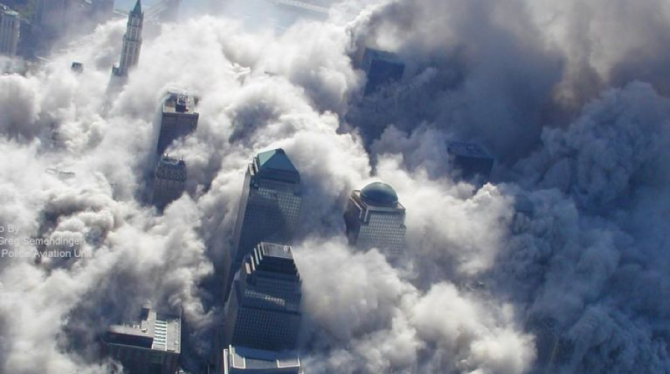
I figured I had about three seconds—not a long time, but enough for me to see which of my staff were nearby and find a place for cover. I quickly lay down by a fruit smoothie stand that my family and I had visited two months before, and waited for the cloud to envelop me. All at once, there was a loud “thunk”; the lights went out; and it was pitch-black. It was difficult to breathe because the dust was thick and acrid. Unbeknownst to us, the South Tower had just collapsed.
Sound the Shofar
This is the point in the story where G-d should come into play, because the idea of dying right there and then was very real. I have often fantasized that I heard shofars blowing as the building was collapsing to announce the end of the world or herald the deaths of the many. At this point, I remembered a Yom Kippur prayer, Unetaneh Tokef, which says, “On Yom Kippur, it is decided who shall live and who shall die; who shall die by fire, who by drowning…” — or who by terrorism? Yet I did not really think of G-d. My first thought was of Ruth my wife, and of my kids. I thought if I die here, she is going to kill me. Funny, isn’t it? On the one hand, there is G-d; on the other hand, there is family. Are they the same? Well, here is one of my conclusions: Family is important — so important that if I died, I wanted to die thinking of my family.
After a few minutes, the smoke lessened, and I reached into my suitcase and pulled out my favorite blue shirt to use as a mask. (It’s the same shirt that I am holding in this People magazine photo.)

People Magazine photograph: The author is second from the left.
When the dust had cleared somewhat, there still remained little or no light. I called out to two of my employees who were close by to see if they were OK. They were also calling out for me to see if I was OK. As we were checking on each other, I heard people screaming. A fireman said, “Shut up, and we will all get out.” Another person said, “Everybody stand up and hold hands.” Another firefighter said that he had a flashlight. I said, “I know where we are,” and began to call out the landmarks as we started walking: “This is the sushi stand … next is the sandwich shop … then Borders bookstore,” as we walked toward the Fulton Street exit. After what seemed like an eternity, but was really only several minutes, we went around a corner, up some stairs and out streetside to a scene that resembled a Godzilla movie.
There was thick dust covering everything and everyone, with building pieces everywhere. The revolving door had been blown off its spindle and was lying precariously against the exit. People were walking around in shock. Several of us helped people walk towards City Hall, away from the World Trade Center. The picture of me in People magazine was taken as we walked up Fulton Street and away from WTC 6. A block from the WTC, a restaurant was handing out water. I grabbed a cup, rinsed out my mouth and shared the water with my colleagues. I then proceeded to look for a phone, to tell Ruth that I was alive. There were long lines at every pay phone, so I continued to walk uptown.
The scene was surreal. Thousands of people — some covered in dust and carrying briefcases, others looking like they were just walking home from work — were leaving the Battery Park neighborhood and the World Trade Center area on foot. Some were lining up to get on buses; others were heading to walk across the Brooklyn Bridge. I was in a science fiction movie. I decided not to take a bus because it could be a target for terrorists and started walking uptown.
When I reached the heart of Chinatown, I heard people scream. I turned around to look, but was too numb to comprehend that Tower One — my tower — had just collapsed. I realized that my family would be in a state of panic and began nervously to look for any phone. Ten minutes later, I found a print shop that allowed me to call my family. After several unsuccessful tries, I finally reached Ruth. The feeling of relief was indescribable.
I think this is a good place to talk about G-d and how my view of G-d evolved on 9/11. In Torah, we have many different views of G-d. We have the angry G-d, threatening to destroy the world, as in Parashat Noakh. There is the forgiving G-d — the one Moses called on after the incident of the Golden Calf.
In Reconstructionist and Reform prayer books, we invoke aspects of G-d in our prayers, such as G-d the bringer of Light, G-d as bringer of peace, or the Shekhinah, the feminine aspect of G-d.
I was taught in Hebrew school that G-d watches over us: I guess you know the drill, AND that did not jibe with the reality of 9/11.
One of the truly powerful lessons I learned on 9/11 was that in a time of great stress and danger, people helped one another. In the stairs, if you needed some assistance, you got it. On the street, if you looked like you were going to fall, others came to your aid.
Let me give you some examples of cooperation. There are stories of people taking complete strangers home with them until their fellow New Yorkers could find a way home. One of my employees helped a woman down 50 flights of stairs and out of the building. He then helped her contact her husband so she could get home. During the descent, I was carrying my suitcase and a briefcase. A member of my staff took my briefcase to ease my load. In fact, while he was running away from the collapsing building, someone commented that it was a beautiful briefcase and asked him where he got it. In another example, while in the stairwells there was an older man who needed help. Two members of his firm held his arms as he made his way down the stairs. The amount of cooperation and unity that was displayed that Tuesday fills me with great pride and hope.
That is G-dliness.
There is no good way to sum up this experience. I am very happy that we did not lose any staff, but it makes me very sad that so many lost their lives that day. Knowing how narrowly I escaped makes me all the more aware of the grief of the victims’ families. Hopefully, September 11 will be the last event of its kind, and we will be able to look back on it not only with sorrow, but also with a sense of satisfaction that we emerged stronger, as a nation and as individuals.

